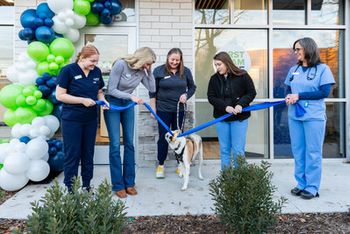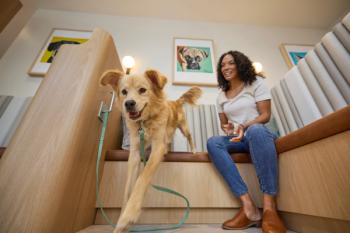
New facility, new visibility, new growth
Dr. Troy Bearden likens building a new hospital to walking a tightrope without a net. "You take a chance and hope you don't fall," he says. For him and his partner, Dr. Catherine Mabe, the risk paid off. Their 5,300-square-foot Shallowford Animal Hospital in Chattanooga, Tenn., more than doubles the size of their former facility and won a Merit Award in the 2002 Veterinary Economics Hospital Design Competition. Two years after opening, the doctors still see new-client numbers increase 30 percent a month.
Dr. Troy Bearden likens building a new hospital to walking a tightrope without a net. "You take a chance and hope you don't fall," he says. For him and his partner, Dr. Catherine Mabe, the risk paid off. Their 5,300-square-foot Shallowford Animal Hospital in Chattanooga, Tenn., more than doubles the size of their former facility and won a Merit Award in the 2002 Veterinary Economics Hospital Design Competition. Two years after opening, the doctors still see new-client numbers increase 30 percent a month.
Shallowford Animal Hospital in Chattanooga, Tennessee. Photo by Robert Boyer, Shoot the Works.
Competition judges praised the facility's high-quality floor plan and open cat boarding area. "The curving exam walls add interest," said one judge. "The interior is gorgeous," praised another.
A nomad takes root
Dr. Bearden was running a house call practice in 1994 when Dr. Mabe asked him to join her and put down roots. "I had to really think about giving up the freedom that my house call practice afforded me, but Dr. Mabe offered me the opportunity to create something special," says the 1987 Auburn graduate.
Dr. Bearden had performed orthopedic surgery for Dr. Mabe and Dr. Charles Byles. When Dr. Byles announced his plans to retire in 1993, Dr. Mabe knew she needed another doctor; the hospital was too big for one person.
Housed in an industrial park in a growing part of town, the hospital saw a strong pool of potential clients, but Dr. Bearden says few people knew they were there. "We shared space with a restaurant, but it went under, which meant less foot traffic for us," says Dr. Bearden. "Plus we were set back from the road; I knew our lack of visibility would limit growth."
A diagonal wall with curved soffit and a checkerboard tile floor add whimsy in the reception area. The owners use the alcoves between the exam rooms to house large scales, a complimentary coffee and juice bar and an aquarium. The curved reception desk separates dog and cat waiting; custom-made cat condos are visible in the back. Photo by Robert Boyer, Shoot the Works.
When the restaurant closed, Dr. Bearden says the partners considered expanding into the vacant bay and remodeling, but they soon realized that the facility would never be conducive to high-quality veterinary medicine. "Cutting corners wouldn't produce a hospital that reflected the high-quality medicine we practice," he says.
Wanting to stay in the area, yet wary of high property costs, Dr. Bearden took note of a city plan to straighten two roads that bisected the major artery one mile from the old hospital. The move created a triangular plot, which the land owner listed at $150,000. In response, Dr. Bearden hired a negotiator to bid $50,000. The owner accepted the offer and put in the needed sewer line.
By the time Dr. Bearden was ready to secure a construction loan, an appraisal valued the land at $250,000, so Dr. Bearden used the land as security for the construction loan. The bank held a lien against the land, and Drs. Bearden and Mabe refinanced a loan. "We didn't need to put any money down, which was a relief," Dr. Bearden says with a laugh. He hired a certified public accountant to negotiate with local banks to find a construction loan that met the owners' needs, and Dr. Bearden secured an interest rate that didn't change when the building was complete.
Starting from scratch
Drs. Bearden and Mabe reviewed back issues of Veterinary Economics for design ideas. They hired Gates Hafen Cochrane Architects, of Boulder, Colo., to draft a sketch.
Each exam room features a unique decor with coordinating fabric and countertops. The closed cabinet above houses cleaning supplies while drawers store medical equipment. A magnetic strip above the sink holds instruments. The stainless steel cap on the coved flooring prevents cracks. Photo by Robert Boyer, Shoot the Works.
Next, a local builder referred Dr. Bearden to area architect Frank McDonald. The property's shape and existing easement suggested the stepped floor plan. Varied roof heights and angles add interest, and all the exterior walls face a street. For easy access, Drs. Bearden and Mabe positioned the entrance off a less-traveled street.
McDonald says his biggest challenge was working with a tiny piece of leftover property. "An old road bed bisected the site, which led to drainage problems," he says.
Inside, the practice features a soft gray and blue palette, and a diagonal interior wall with a curved soffit at the back of the reception area offers a whimsical touch. "We wanted to make an impression, and the reception area sets the tone for the hospital," McDonald says. The reception desk divides cat and dog waiting, and gray and white checkerboard porcelain tile flooring withstands heavy use.
Custom-built cat condos offer upscale boarding and overlook the cat waiting area. For maximum flexibility, the condos include small portholes that allow boarded cats to roam horizontally through the unit. A removable floor provides up to 7 feet of vertical space for boarded cats. Side windows give cats a view of the aquarium in the reception area. "The condos were a splurge that clients love," Dr. Bearden says.
Spanning the back of the reception area, four exam rooms line the whimsical diagonal wall. The diagonal wall allowed the "back of house" areas to take up less space on one end and more on the other to make the area more functional and improve circulation. In the exam rooms, soft grays and blues and rounded corners mimic the look established in the reception area. Vinyl sheet flooring covers the working areas.
Behind the exam rooms lies a spacious pharmacy and lab area. Dr. Bearden says he appreciates the pharmacy island, which provides space for write ups, call backs, and label printing. Floor-to-ceiling cabinets with doors maximize space.
Treatment and surgery occupy the north end of the building, and Dr. Bearden says distinct dental and doctors' space improves efficiency. Isolation is located near the wards. Large windows keep critical patients visible.
Four built-in exam tables, two with wet units, provide ample workspace in the treatment area, and three windows offer natural light. Team members use the table at the back left for dental procedures; the necessary equipment is mounted at the end. Photo by Robert Boyer, Shoot the Works.
At the opposite end of the building, the kennels feature a fenced yard for exercise. Each run uses three removable side-by-side grates and is elevated 6 inches for easy cleaning. The 800-square-foot second story remains unfinished.
Visibility packs a punch
During construction, Dr. Bearden visited the site up to twice a day to keep workers on track. He caught a misplaced wall that would have shrunk the lab by 2 feet. "We wouldn't have had enough counter space," he says. After the partners moved in, they discovered workers had cut costs by installing cheaper cord reels in the ceiling. "We needed $500 reels, and they installed a style that cost $50," he says. The reels burned up with constant use, and the contractor paid for the repair.
In hindsight, Dr. Bearden says the light-colored exam-room floors show dirt in the corners, and staff members wish for a larger isolation area. But overall, Dr. Bearden says the hospital is nearly perfect. "Moving from the old hospital to the new one was like stepping into the sunshine," he says. Dr. Mabe focuses on the benefit of sunlight even more literally. "I like seeing the world," she says. "It's good for morale." In the former facility, the front doors offered the only natural light.
The hospital's improved visibility has boosted client traffic considerably. "We never attracted drive-by clients before," says Dr. Bearden. "Now, that's the most common response clients check on our new-client forms." In the months after moving in, new-client numbers jumped by 50 percent.
And Dr. Bearden says the new facility improves the quality of medicine by providing a clean environment that prevents cross contamination. Five separate environmental zones prevent germs and odors from spreading. "I think we practiced good medicine before, but clients didn't expect it based on the previous building's appearance," he reflects.
In the double surgery suite, a shelf at the back keeps monitoring equipment visible, and windows look into treatment for improved commuication. Sheet vinyl flooring is easy to clean. A separate air-conditioning unit allows the surgeon to control room temperature. Photo by Robert Boyer, Shoot the Works.
For others planning similar projects, Dr. Mabe encourages patience. "This project took a long time to complete-nine to 12 months longer than we anticipated," she says. "Expect a juggling act to stay within the budget, too." Dr. Mabe says that from conception to completion, the construction process took about four years.
Dr. Bearden recommends using professionals to help you do everything from buying land and negotiating a loan to designing the hospital. "Build a knowledgeable team and pay them what they're worth; in the long run you'll be happier," he advises. "We're proud of our facility. And the money we spent is paying off."
Carolyn Chapman, a former Veterinary Economics associate editor, is a freelance writer in Liberty, Mo. Chapman has written for Veterinary Economics since 1994.
Newsletter
From exam room tips to practice management insights, get trusted veterinary news delivered straight to your inbox—subscribe to dvm360.




